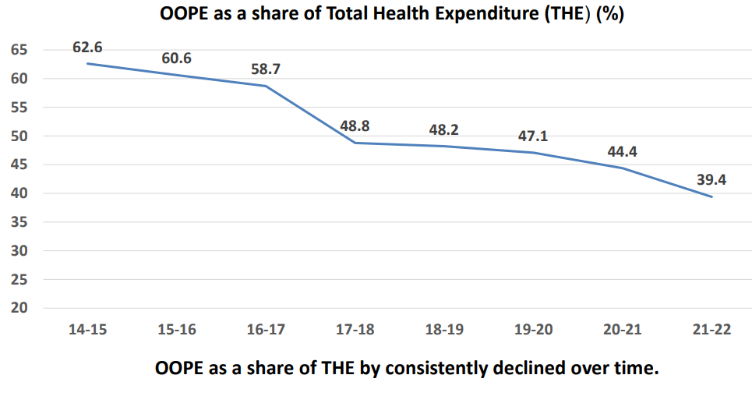A SYSTEM THAT HEALS
Relevance: GS 2 – Issues relating to development and management of Social Sector/Services relating to Health, Education, Human Resources.
Why in the News?
- The National Health Policy (NHP) 2017 aims for universal access to quality, affordable healthcare.
- Government health expenditure is on the rise according to National Health Accounts (NHA) data, including provisional estimates for 2020-21 and 2021-22.
- Out-of-pocket spending is consistently decreasing.
Government Health Expenditure (GHE) as Proportion of GDP
- GHE as a proportion of GDP witnessed an unprecedented 63% increase between 2014-15 and 2021-22.
- It escalated from 13% of GDP in 2014-15 to 1.35% in 2019-20, further climbing to 1.60% in 2020-21 and 1.84% in 2021-22.
Per Capita Government Health Expenditure:
- Per capita GHE rose from Rs 1,108 to Rs 2,014 between 2014-15 and 2019-20.
- This upward trajectory persisted, with per capita government expenditure reaching Rs 2,322 in 2020-21 and Rs 3,156 in 2021-22, nearly tripling the 2014-15 level according to provisional estimates.
- Expenditure on Government-Financed Insurance surged 4.4 times from Rs 4,757 crore in 2013-14 to Rs 20,771 crore in 2021-22.
Investments in Health Insurance Schemes
- Rising investments are evident in schemes like the Ayushman Bharat Pradhan Mantri Jan Arogya Yojana (ABPMJAY) and state health assurance/insurance schemes.
- The share of social security expenditure on health, encompassing government-funded health insurance, medical reimbursement to government employees, and social health insurance programs, increased from 5.7% in 2014-15 to 9.3% in 2019-20 of the total health expenditure.
Decline in Out-of-Pocket Expenditure (OOPE)
- There’s been a consistent decline in OOPE as a share of total health expenditure, decreasing from
62.6% to 47.1% between 2014-15 and 2019-20.
- This trend continued with OOPE dropping to 4% in 2020-21 and to 39.4% in 2021-22according to provisional NHA estimates, providing significant relief to people.
- The health system’s resilience was evident as OOPE continued to decline even during the Covid-19 pandemic (2020-21 and 2021-22).
Factors Contributing to Declining Out-of-Pocket Expenditure (OOPE)
Access to Medical Treatment Through AB-PMJAY:
AB-PMJAY beneficiaries no longer need to resort to borrowing or selling assets to obtain surgical and medical treatment for severe conditions like cancer.
Increased Utilization of Government Facilities:
Utilization of government facilities, particularly for inpatient care and institutional deliveries, has risen based on National Sample Survey (2017-18) data.
Free ambulance services, strengthened government secondary and tertiary services, and the Pradhan Mantri National Dialysis Programme (which has provided over 2.59 crore free dialysis sessions since 2016) contribute significantly to reducing OOPE.
Reduction in Drug and Diagnostic Costs:
Drugs and diagnostics are major contributors to out-of-pocket spending.
Free drugs and diagnostic services in facilities, including over 1,69,000 Ayushman Arogya Mandirs (AAMs, Health and Wellness Centers), result in significant financial savings for families.
AAMs at subcentres offer 105 medicines and 14 diagnostic tests free, while those at primary health centres are mandated to provide 172 medicines and 63 diagnostic tests free.
Early screening and free treatment of non-communicable diseases, as required at AAMs, can extend healthy life and prevent catastrophic expenditure on future severe, life-threatening complications.
Impact of Jan Aushadhi Kendras and Price Regulation
- More than 10,000 Jan Aushadhi Kendras provide over 1,900 quality generic medicines and nearly 300 surgical items at low costs across practically all districts.
- Since 2014, consumers have saved approximately Rs 28,000 crore through this scheme.
- Price regulation of essential medical items like coronary stents, orthopaedic knee implants, cancer drugs, and other essential medicines has resulted in annual savings of Rs 27,000 crore for the people.
Increasing Government Health Expenditure
- Economic surveys indicate a rising trend in government health-related expenditure.
- As a share of GDP, it was 6% in FY 2020-21 and 2.2% in FY 2021-22 (revised estimate).
- Economic survey estimates also include spending on crucial social determinants of health, particularly water supply and sanitation.
Impact of Water Supply and Sanitation
- Access to safe drinking water and sanitation has notable positive health effects.
- At the launch of the Jal Jeevan Mission in 2019, only 17% of rural households had access to tap water, which has now increased to approximately 76%.
- According to a WHO report, providing tap water to every rural household would save four lakh lives over five years.
- The WHO also estimates that the Swachh Bharat Mission (SBM) Grameen, which achieved rural India being open defecation free (ODF), would have prevented over 3,00,000 deaths (due to diarrhoea and protein-energy malnutrition) between 2014 and October 2019.
Trends Towards a Progressive Health System
- Rising public health expenditure and a consistent decline in Out-of-Pocket Expenditure (OOPE) alongside increasing shares of Government Health Expenditure (GHE) and social security schemes on healthcare signify a shift towards a more progressive health system.
- Funds allocated for infrastructural support under various schemes like Pradhan Mantri Swasthya Suraksha Yojana (aimed at establishing medical colleges and new AIIMSs), Pradhan Mantri Ayushman Bharat Infrastructure Mission, and Emergency Response and Health System Preparedness Package (aimed at enhancing pediatric and adult ICUs) are bolstering the country’s health infrastructure.
- Additionally, health grants to local bodies under the 15th Finance Commission award, amounting to Rs 70,000 crore, are being invested in the primary health system.
Path Towards Universal Health Coverage
- India’s health system is on the path of reform, performance, and transformation to achieve Universal Health Coverage in the near future.
- Recent trends of increasing government financing for health and decreasing stress of OOPE indicate progress in the right direction.
Source: The Indian Express
Mains question
Discuss the recent trends in India’s healthcare expenditure and their implications on achieving Universal Health Coverage. Evaluate the role of government initiatives in strengthening the health infrastructure and reducing Out-of-Pocket Expenditure. (250 words)





